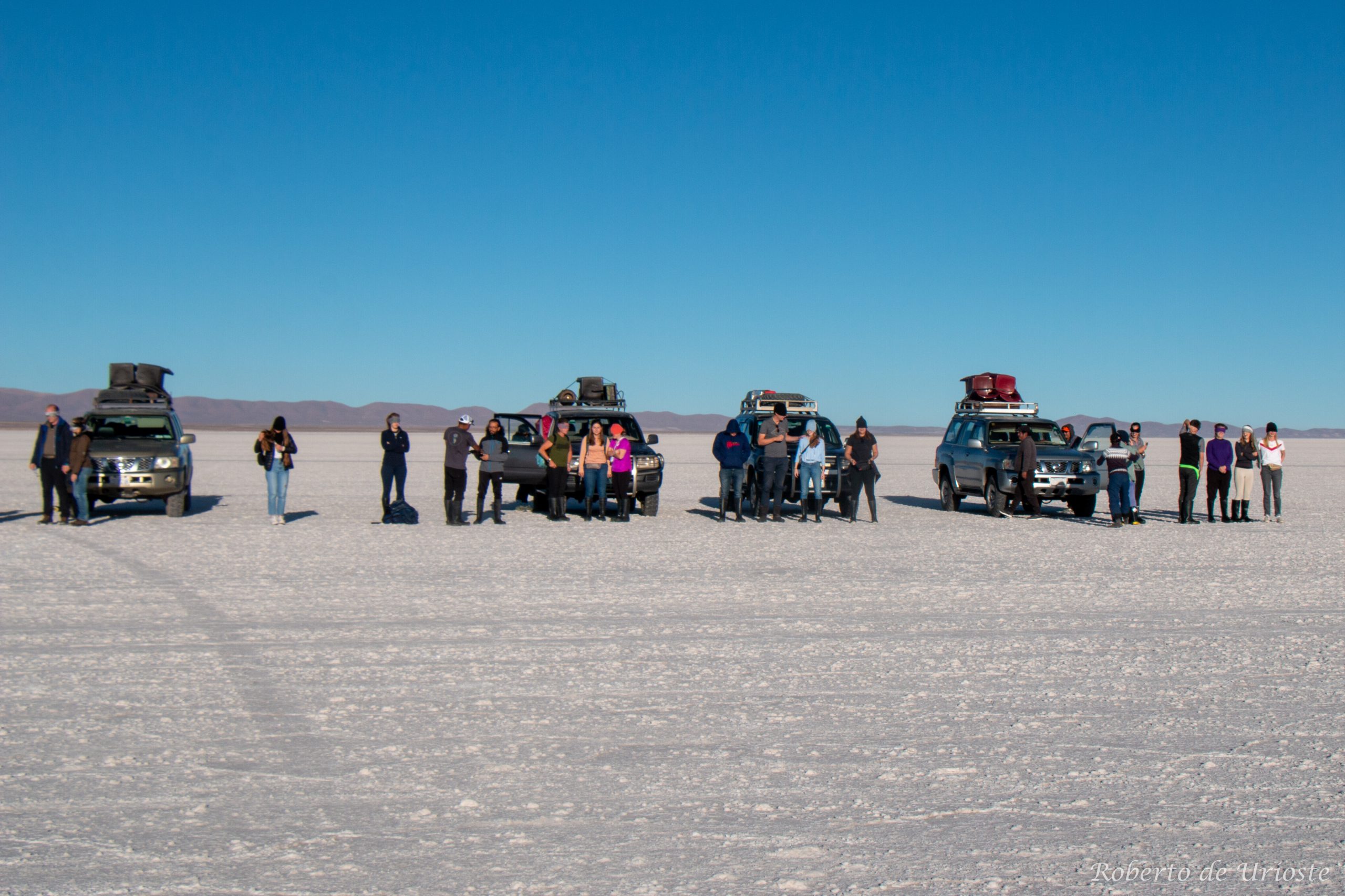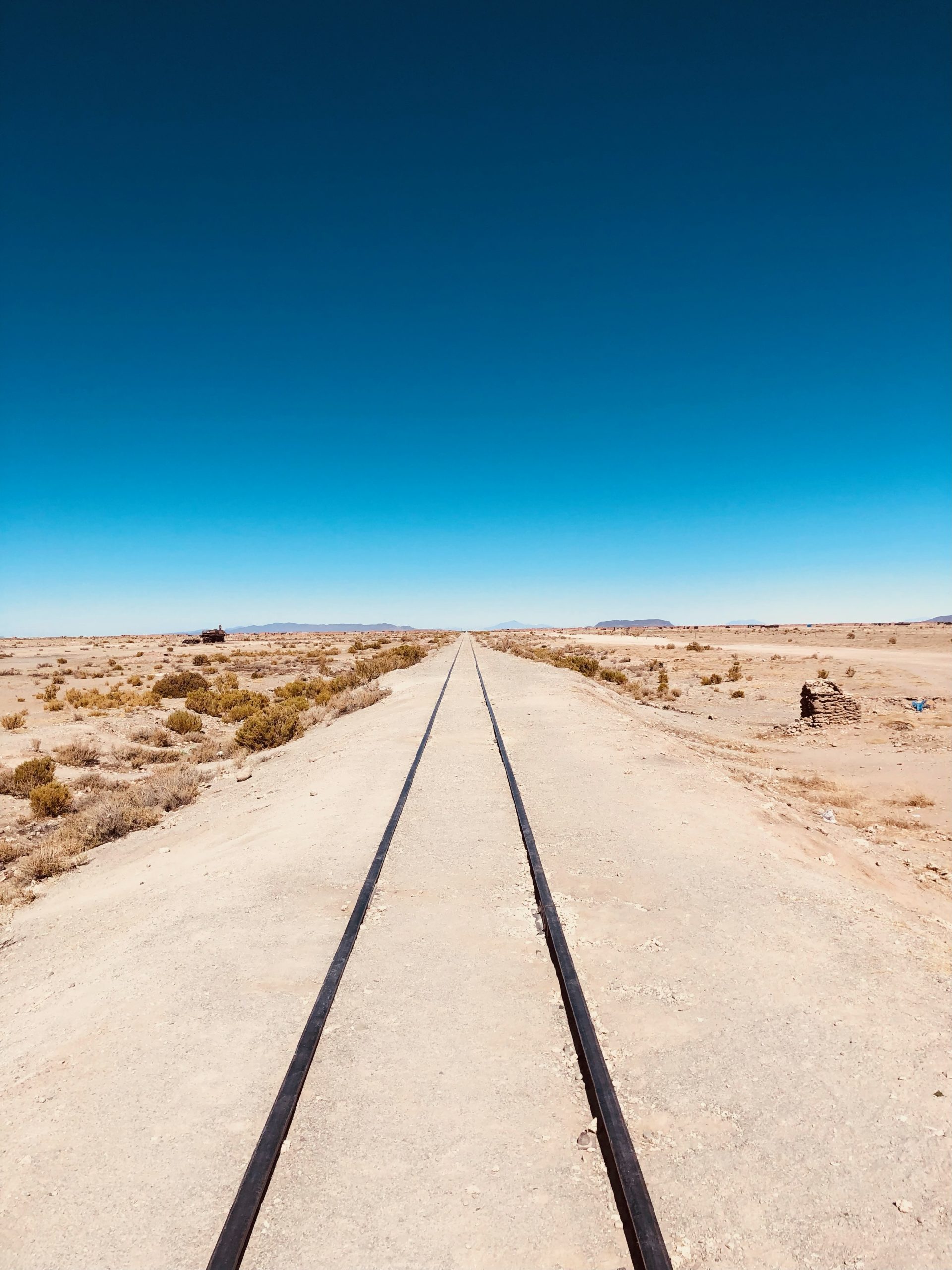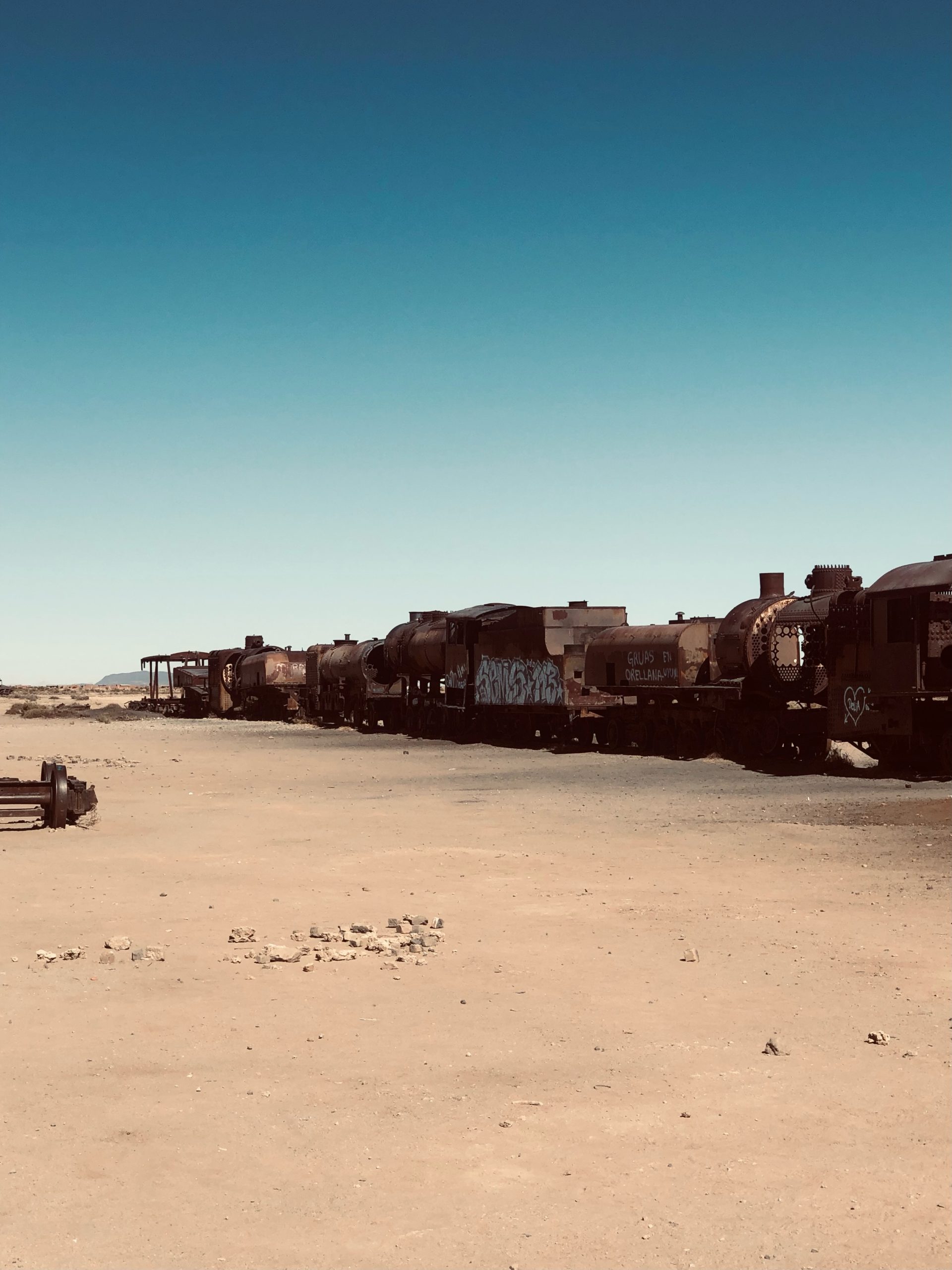
The Uyuni Salt Flats have been one of the most incredible places I have visited so far: This beautiful salt desert, coupled with the surreal landscapes, makes it a travellers’s dream. In this guide, we’ll delve into the wonders of the Bolivian Salt Flats, exploring its tours, accommodations, best times to visit, and the highlights of this incredible place in South America.
The Bolivia’s Salt flats are located in the southwestern region of Bolivia, in the Daniel Campos Province. Perched at an altitude exceeding 3,600 meters above sea level, the Salar Uyuni unfolds as a remote and extraordinary landscape. This unique terrain showcases prehistoric lakes, desert, impeccably shaped conical volcanoes, and surprising wildlife.
Fascinating Uyuni Salt Flats Facts:
- World’s Largest Salt Flat: Covering approximately 10,500 square kilometers (4,000 square miles), Salar de Uyuni holds the title as the world’s largest salt flat. Remarkably, it’s more than twice the size of the second largest, Salinas Grandes in Argentina.
- Formation: Originating from lakes that existed around forty thousand years ago, these lakes gradually evaporated over time, leaving behind a pool of brine covered by a few meters of salt crust, resulting in its extraordinary flatness.
- Surrounded by Dormant Volcanoes: This vast salt flat is encircled by dormant volcanoes and boasts a couple of ‘islands,’ which are essentially the summits of extinct volcanoes.
- Seasonal Transformation: During the wet season, the salt flat is covered by a thin layer of water, creating a mesmerising mirror effect that reflects the sky, making it the world’s largest natural mirror.
- Visible from Space: Its vast, flat surface makes Salar de Uyuni visible from space. GPS satellites often use this salt flat as an ideal reference target due to its wide and flat expanse.
- Enormous Salt Reserves: Salar de Uyuni houses an astounding 10 billion tons of salt, making it a valuable natural resource.
- Lithium Deposit: Apart from its salt wealth, it holds the world’s largest deposit of lithium, a precious metal widely used in various applications, including batteries. However, the extraction of lithium raises concerns as it poses a threat to the salt flats.
- Unique Wildlife: Home to distinctive wildlife, the salt flat hosts three species of pink South American flamingos that feed from shadow pools. Additionally, llamas or alpacas can often be seen grazing around its edges.
- High Altitude Location: Positioned at a staggering altitude of 3,656 meters (11,995 ft) above sea level, Salar de Uyuni offers a unique high-altitude experience to visitors.

How To Get To Salar de Uyuni
Reaching Salar de Uyuni can be an exciting adventure in itself due to its remote location near the Bolivia-Chile and Bolivia-Argentina borders. Various options are available for travelers, and the choice depends on your origin and future travel plans. Here are the most popular routes for reaching this extraordinary destination:
No matter where you are coming from your journey to the Salt Flats will have to start your tour from Uyuni.
From Peru: If you’re starting your journey from Peru. You can fly to La Paz and then take a night bus from La Paz to Uyuni.
From Within Bolivia: For those traveling within Bolivia, You can go from La Paz to Uyuni, with the journey typically taking around 8 hours on an overnight sleeper bus. If you are departing from Potosi the bus is taking usually 9 hours.
From Chile: Travelers from Chile can embark on 3 or 4-day tours of Salar de Uyuni from San Pedro de Atacama. This option is highly recommended for those wishing to explore the salt flats from Chile. Crossing the border to Uyuni independently can pose logistical challenges, making organized tours the preferable choice for a hassle-free experience.
Uyuni Salt Flats Tours:

You don’t have to plan in advance if you are not a planner, in Uyuni there are many tour agency where you can walk in and book for the tour even for the same day!
There are different options when it comes to visiting the Sal Flats: one day tour, two days tour, three days tours.
Exploring the Uyuni Salt Flats through a 3-day tour is undeniably the most popular and captivating way to experience the vast expanse of the world’s largest salt flats. My recommendation is to opt for the 3 days tour. The 3 days tour allows you to marvel at the breathtaking landscapes of the Salt Flats but also offers a unique opportunity to pass through the amazing Eduardo Avaroa National Reserve: The journey will take you along rugged paths, offering glimpses of puffing volcanoes, bubbling geysers, and stunning lagoons adorned with vibrant hues, hosting three distinct species of endemic flamingos. Among these wonders, Laguna Colorada stands out, a picturesque lake painted in rusty red tones, situated at an impressive altitude of nearly 4300m. This striking natural marvel also boasts a small visitor center, enhancing the overall experience of our exploration.
To get some ideas of the english speaking tours available and what is the itinerary you can check the following options:
- Red Lagoon & Uyuni Salt Flats 3-Days: This 3 days tour is starting and finishing in Uyuni.
- Uyuni Salt Flats and San Pedro de Atacama 3 days: This 3 days tour is starting in Uyuni and finishing in San Pedro de Atacama Chile and this is the tour I took when I visited the Salt Flats.
- Salt Flat Tour with Lunch 1 day: This 1 day tour starting and finishing in Uyuni, will drive you through the salt flats with lunch included, this is a good alternative if you don’t want to opt for the 3 days tour.
Best Time To Visit

Determining the best time to visit Salar de Uyuni depends on the kind of experience you seek, as the landscape transforms significantly throughout the year. If witnessing the mesmerizing mirror effect is your goal, plan your visit between March and April when the chances of observing this phenomenon are higher. However, be mindful that the rainy season during these months may cause flooding in certain areas, rendering attractions like Isla Incahuasi inaccessible.
For those desiring optimal weather conditions and unhindered access to all the sights, the period between July and October is ideal. During this time, the climate is delightful, and you can explore the salar and its attractions without any restrictions, ensuring a memorable and unrestricted adventure.
What To Bring
To experience the Salt Flats at its fullest make sure you come prepared and bring the following:
- Sun Protection:
- Sunscreen
- Lip balm
- Sun hat
- Warm Clothing:
- Beanie, gloves, and a scarf or buff for cold, windy days
- Warm clothes for sleeping, including thick socks
- Rain jacket for rainy days
- Sleeping Gear:
- Sleeping bag (for extra warmth and comfort)
- Footwear:
- Flip flops for walking in salty water
- Consider capris or pants that can be rolled up, especially during the rainy season
- Swimwear:
- Swimsuit if you plan to visit hot springs on a multi-day tour
- Lighting and Electronics:
- Headlamp (useful for navigating in the dark)
- Camera for capturing memorable moments
- Hydration:
- Sufficient water to stay hydrated, especially due to the high altitude.
- Travel Insurance: It’s always good to insure your trip but especially in this case, as you will be in a remote place, make sure you are covered for any emergency.
Other Highlights of Salar de Uyuni:
Of course, just being in the middle of the salt flats admiring the beauty of the white ground and the blu sky is per se a highlight, but there are also other awesome experiences you can have when visiting Salar de Uyuni:
Train Cemetery:

The Train Cemetery, or Cementerio de Trenes, is a fascinating and eerie attraction located just outside the town of Uyuni, near the Salar de Uyuni in Bolivia. This unusual site is a resting place for old, rusted-out locomotives and train cars, remnants of Bolivia’s once-thriving railway industry.
During the late 19th and early 20th centuries, Uyuni served as a major transportation hub, particularly for trains carrying minerals like silver and tin from the nearby mines. However, with the collapse of the mining industry and the introduction of more modern transportation methods, these trains were left abandoned in the harsh Bolivian desert.
Today, the Train Cemetery has become a playground for photographers, urban explorers, and curious travelers. The rusted skeletons of trains, some with missing wheels and shattered windows, create a surreal and post-apocalyptic atmosphere. Visitors are free to climb on the trains, explore their interiors, and capture hauntingly beautiful photographs of this decaying industrial graveyard.

Stay in a Salt Hotel: In Uyuni, Bolivia, you can find unique accommodations made entirely of salt, offering an extraordinary experience for travelers: Hotel Palacio de Sal, Hotel De Sal Luna Salada and Casa de Sal (which is in the town of Uyuni, versus in the salt flats like the other two).
Every element, from the walls and floors to the ceilings, furniture, and even sculptures, is meticulously crafted from salt! Intriguingly, due to their construction from salt blocks, these hotels require rebuilding every 10 to 15 years. This is because exposure to rain gradually causes the salt structures to disintegrate over time.
Visit isla Inchausi:

Isla Incahuasi, also known as Inkawasi or Isla del Pescado, this unique island is known for its stunning cactus groves and surreal landscape, making it a popular stop for tourists exploring the salt flats. Isla Incahuasi is situated at the heart of the salt flat and offers panoramic views of the vast white expanse surrounding it. Visitors can hike to the top of the island, where they can enjoy breathtaking views of the salt flat and the distant Andes Mountains. The island is also home to numerous giant cacti, some of which are over 1,200 years old, adding to its mystical charm.

Eduardo Avaroa Andean Fauna National Reserve:

Commonly known as Avaroa National Reserve, is a protected natural area where you will pass through if you opt for a 3 day trip from Uyuni to San Pedro de Atacama.
This national reserve is renowned for its diverse and unique landscapes, ranging from high-altitude deserts to volcanoes, geothermal fields, and colorful lagoons. It is one of the most biodiverse regions in Bolivia, home to various species of wildlife, including flamingos, vicuñas, Andean foxes, and more.

One of the notable attractions within the Avaroa National Reserve is the Laguna Colorada, a stunning red-colored lake inhabited by flamingos. The lake’s vibrant hue is caused by sediments and algae, creating a surreal and picturesque sight. Other attractions in the reserve include the Sol de Mañana geothermal area, where visitors can observe fumaroles and hot springs, and the Salvador Dali Desert, known for its surreal rock formations.

I hope I’ve piqued your interest in Salar de Uyuni! Feel free to reach out if you have any questions (DM on instagram @sere_travels) I’m more than happy to share more about this incredible destination!
If you want to read more about Bolivia check my other blog post: Preparing your trip to Bolivia.
Disclosure: This post may contain affiliate links, which means I may earn a commission if you make a purchase through these links. Please note that I only recommend products and services that I personally use and love and the income goes to supporting this website. Thank you for your support!

No Responses